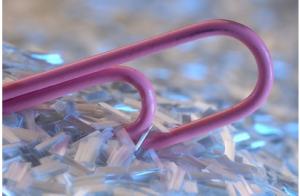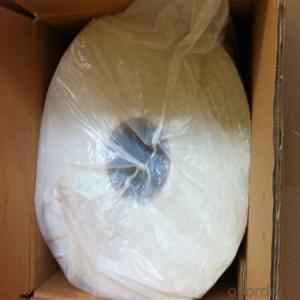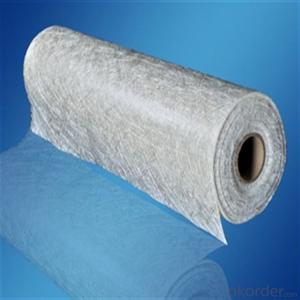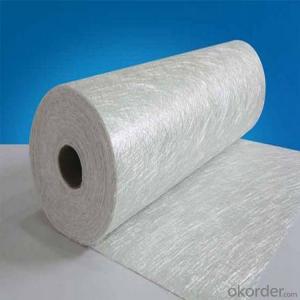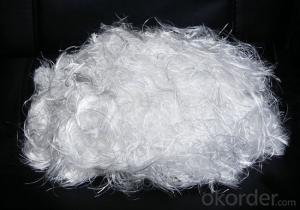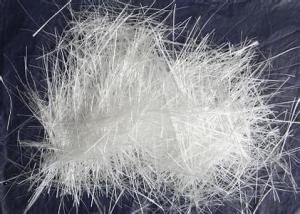E Glass Fiber Chopped Strands For Thermoplastic
- Loading Port:
- Shanghai
- Payment Terms:
- TT or LC
- Min Order Qty:
- 20000 kg
- Supply Capability:
- 200000 kg/month
OKorder Service Pledge
OKorder Financial Service
You Might Also Like
Description:
Chopped Stands for Thermoplastic are based on silane coupling agent and special sizing formulation, compatible with PA,PBT/PET, PP, AS/ABS, PC, PPS/PPO,POM, LCP;
E-Glass Chopped Stands for thermoplastic are know for excellent strand integrity, superior flowability and processing property, delivering excellent mechanical property and high surface quality to its finished product.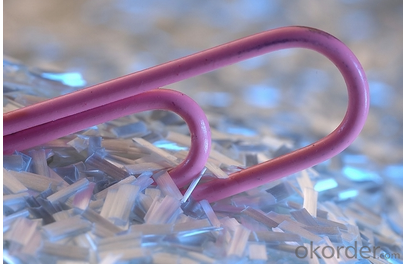
Product Features:
● Extremely low resin demand, delivering low viscosity to BMC paste
● High impact strength; High LOI rate
● High strand stiffness; Compatible with rubber
Product Specifications:
Property | Fibre diameter | Moisture Content | Size Content | Chop |
(%) | (%) | (%) | (%) | |
Mathods | IS01888 | ISO3344 | ISO1887 | |
3mm | ±10 | ≤3.0 | 0.1±0.05 | 98 |
6mm | ||||
9mm | ||||
12mm |
● Special specification can be produce according to customer requirements.
Packaging:
Each bag can be taken (15-25kgs)。 Could also take a big container bag.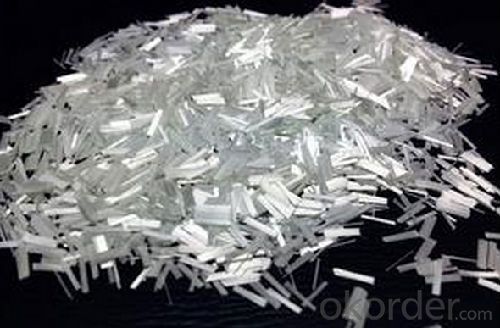
Storage:
Unless otherwise specified, It should be stored in a dry, cool and rain-proof area. It is recommended that the room temperature and humidity should be always maintained at 15℃~35℃ and 35%~65% respectively.
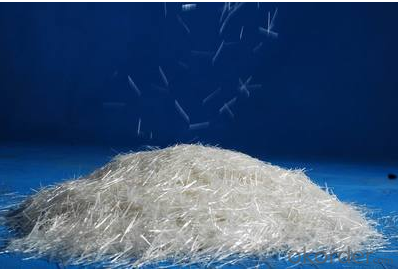
FAQ:
1.Who will pay for the express cost ?
A: We can support you free samples ,but express cost will be paid by you .
2.How long is the delivery time?
A:within 10-15 days after receiving depos
- Q:How does the orientation of fiberglass chopped strand affect its strength?
- The strength of fiberglass chopped strand is greatly influenced by its orientation. Fiberglass chopped strand consists of randomly oriented glass fibers held together by a sizing agent. When these strands are added to a composite material, their orientation can affect the overall strength of the final product. Typically, the strength of fiberglass chopped strand is determined by the alignment of the fibers with the applied load. Fibers that are aligned parallel to the load direction provide the highest strength as they effectively carry and distribute the stress. This is known as the longitudinal or axial direction. In contrast, fibers that are aligned perpendicular to the load direction, also known as the transverse direction, offer lower strength. This is because these fibers are less effective at resisting the stress and are more prone to breakage. Additionally, the transverse orientation can lead to delamination or separation between the fibers and the resin matrix, resulting in reduced overall strength. The presence of fiber misalignment or voids in the composite material can also impact the strength of fiberglass chopped strand. Non-uniform distribution or improper alignment of the fibers can create weak areas or stress concentration, diminishing the material's overall strength. To maximize the strength of fiberglass chopped strand, it is crucial to ensure proper fiber alignment and distribution within the composite material. This can be achieved through meticulous manufacturing processes, such as employing techniques for uniform and controlled fiber orientation, ensuring adequate resin impregnation, and minimizing the presence of voids or defects. In conclusion, the orientation of fiberglass chopped strand is a crucial factor in determining its strength. By ensuring proper fiber alignment and distribution, the material's ability to withstand applied stress can be enhanced, ultimately contributing to its overall strength.
- Q:Can fiberglass chopped strand be used in the production of insulation foams?
- Yes, fiberglass chopped strand can be used in the production of insulation foams. Fiberglass is a commonly used material in insulation due to its excellent thermal performance and durability. Chopped strand is essentially small strands of fiberglass that are cut into shorter lengths. These chopped strands can be mixed with other materials, such as resins or foaming agents, to create insulation foams. The use of fiberglass chopped strand in insulation foams offers several benefits. First, fiberglass is a good insulator, which means it can effectively trap heat or cold and prevent it from escaping or entering a space. This property makes it ideal for use in insulation materials, where the goal is to regulate temperature and improve energy efficiency. Second, fiberglass chopped strand can enhance the structural integrity of insulation foams. By reinforcing the foam, the chopped strands can help improve its strength, durability, and resistance to deformation. This is particularly important in applications where the foam will be subject to mechanical stress or compression. Lastly, fiberglass chopped strand is relatively lightweight, making it suitable for use in lightweight insulation foams. This can be advantageous for applications where weight is a concern, such as in the automotive or aerospace industries. In conclusion, fiberglass chopped strand can be successfully used in the production of insulation foams. Its thermal insulating properties, reinforcing capabilities, and lightweight nature make it a valuable component in creating high-performance insulation materials.
- Q:Can fiberglass chopped strand be used in the production of automotive body parts?
- Yes, fiberglass chopped strand can be used in the production of automotive body parts. It is commonly used as a reinforcing material in composite materials, providing strength, rigidity, and impact resistance to the final product.
- Q:What are the main applications of fiberglass chopped strand?
- Fiberglass chopped strand is a versatile material that finds numerous applications across various industries. The main applications of fiberglass chopped strand can be categorized into the following: 1. Construction: Fiberglass chopped strand is extensively used in the construction industry for reinforcing concrete structures. It adds tensile strength and durability to the concrete, making it resistant to cracks and other damages. It is commonly used in the construction of bridges, buildings, tunnels, and other infrastructure projects. 2. Composites: Fiberglass chopped strand is a key component in the manufacturing of composite materials. It is used to reinforce polymers, resins, and other matrix materials to create strong and lightweight composites. These composites find applications in industries like automotive, aerospace, marine, and sports equipment manufacturing. 3. Insulation: The excellent thermal and acoustic insulation properties of fiberglass chopped strand make it an ideal material for insulation applications. It is used to insulate walls, roofs, pipes, and other areas where thermal or acoustic insulation is required. Fiberglass chopped strand insulation helps in conserving energy, reducing noise transmission, and maintaining comfortable indoor environments. 4. Filtration: Fiberglass chopped strand is widely used in the production of various filtration media. Its high strength and chemical resistance make it suitable for applications like air filters, oil filters, water filters, and dust collectors. Fiberglass chopped strand filters are known for their high efficiency and long service life. 5. Electrical & Electronics: Due to its electrical insulation properties, fiberglass chopped strand is used in the manufacturing of electrical and electronic components. It is commonly used as insulation for wires and cables, printed circuit boards, transformers, and electrical appliances. It provides protection against electrical shocks and ensures reliable performance of these devices. 6. Automotive: Fiberglass chopped strand is extensively used in the automotive industry for various applications. It is used in the production of automotive parts like bumpers, body panels, interior trims, and engine components. Fiberglass chopped strand-reinforced composites offer high strength-to-weight ratio, corrosion resistance, and design flexibility, making them suitable for automotive applications. Overall, fiberglass chopped strand is a versatile material with a wide range of applications. Its strength, durability, thermal insulation, electrical insulation, and chemical resistance properties make it a preferred choice in various industries.
- Q:How does the moldability of the chopped strand affect its performance?
- The performance of the chopped strand is significantly influenced by its moldability, which is the ability of the chopped strand to adapt and conform to the shape of the mold during the manufacturing process. When the chopped strand exhibits excellent moldability, it can effortlessly assume complex shapes with intricate details. This characteristic allows for its utilization in a wide array of applications that necessitate precise molding, including automotive parts, aerospace components, and consumer goods. Conversely, if the chopped strand possesses inadequate moldability, it can lead to various performance issues. It may fail to fully conform to the mold, resulting in gaps, voids, or uneven distribution of fibers. These issues can compromise the structural integrity and strength of the final product. Moreover, poor moldability can make it challenging to achieve consistent and uniform thickness, resulting in dimensional inaccuracies and variations in the finished product. Hence, the moldability of the chopped strand plays a crucial role in guaranteeing the overall performance and quality of the final product. By carefully selecting chopped strands with excellent moldability, manufacturers can achieve superior structural integrity, dimensional accuracy, and overall performance in their molded products.
- Q:How does the orientation of the chopped strand affect its performance?
- The orientation of the chopped strand plays a crucial role in determining its performance. When the strands are oriented in a specific direction, it enhances the strength and stiffness of the composite material. This directional alignment allows for better load distribution, improved impact resistance, and increased overall mechanical properties. On the other hand, random or unidirectional orientations may result in reduced performance as the loads may not be efficiently distributed, leading to weaker and less durable composite structures.
- Q:Is fiberglass chopped strand lightweight?
- Indeed, fiberglass chopped strand possesses a lightweight attribute. Chopped strand alludes to abbreviated fiberglass fibers, precisely trimmed to a predetermined length. Typically, these fibers are blended with a resin or binder to fashion a composite substance. As fiberglass inherently exhibits a lightweight constitution, these trimmed strands inherit this quality. Consequently, fiberglass chopped strand proves to be an optimal selection for implementations necessitating a lightweight substance, including automotive components, boat hulls, and aerospace constituents. Furthermore, the lightweight nature of fiberglass chopped strand facilitates heightened flexibility and effortless manipulation throughout the manufacturing procedure.
- Q:Can fiberglass chopped strand be used in chemical resistant applications?
- Typically, fiberglass chopped strand is not used in applications that require chemical resistance. Although fiberglass is renowned for its strength and durability, it does not possess inherent resistance to various chemicals. Instead, in situations where chemical resistance is necessary, it is common to employ alternative materials like specialty resins or coatings that are specifically engineered to withstand particular chemicals. These materials offer superior chemical resistance and safeguard against corrosion or deterioration caused by exposure to harmful substances. Consequently, it is advisable to explore alternative materials that are tailored to meet the chemical resistance demands of the application.
- Q:Is fiberglass chopped strand resistant to chemicals?
- Indeed, fiberglass chopped strand typically possesses a high degree of chemical resistance. Comprised of glass fibers and a polymer matrix, fiberglass boasts exceptional durability against a broad spectrum of chemicals. It can endure exposure to a wide array of acids, alkalis, solvents, and other corrosive substances without undergoing substantial deterioration or harm. Nevertheless, the precise chemical resistance of fiberglass chopped strand may fluctuate based on the particular resin employed, the manufacturing procedure, and the specific chemicals employed. It is prudent to consult the manufacturer's specifications or undertake chemical compatibility tests to ascertain the appropriateness of fiberglass chopped strand for a given chemical application.
- Q:How does the quality of fiberglass chopped strand affect its performance?
- The quality of fiberglass chopped strand directly affects its performance in several ways. Firstly, the length and consistency of the strands play a significant role in determining the mechanical properties of the final product. Longer strands tend to provide better reinforcement and increased strength, while shorter strands may result in a weaker and less durable material. Additionally, the diameter and uniformity of the individual strands impact the overall performance of fiberglass. Thinner and more consistent strands enable better resin impregnation during the manufacturing process, leading to improved adhesion between the fibers and the matrix. This, in turn, enhances the material's mechanical properties, such as tensile strength, flexural strength, and impact resistance. Furthermore, the quality of the surface treatment applied to the chopped strand is crucial. A proper surface treatment ensures good compatibility between the fiber and the resin, allowing for better wetting and dispersion. This results in improved interfacial bonding and overall mechanical performance of the final composite product. In summary, the quality of fiberglass chopped strand directly affects its performance by influencing the length, diameter, consistency, and surface treatment of the fibers. These factors determine the material's mechanical properties, adhesion, and compatibility with the matrix resin, ultimately impacting its overall strength, durability, and performance characteristics.
1. Manufacturer Overview |
|
|---|---|
| Location | |
| Year Established | |
| Annual Output Value | |
| Main Markets | |
| Company Certifications | |
2. Manufacturer Certificates |
|
|---|---|
| a) Certification Name | |
| Range | |
| Reference | |
| Validity Period | |
3. Manufacturer Capability |
|
|---|---|
| a)Trade Capacity | |
| Nearest Port | |
| Export Percentage | |
| No.of Employees in Trade Department | |
| Language Spoken: | |
| b)Factory Information | |
| Factory Size: | |
| No. of Production Lines | |
| Contract Manufacturing | |
| Product Price Range | |
Send your message to us
E Glass Fiber Chopped Strands For Thermoplastic
- Loading Port:
- Shanghai
- Payment Terms:
- TT or LC
- Min Order Qty:
- 20000 kg
- Supply Capability:
- 200000 kg/month
OKorder Service Pledge
OKorder Financial Service
Similar products
New products
Hot products
Related keywords
